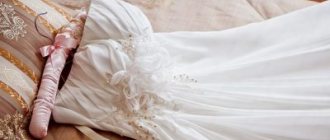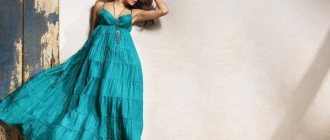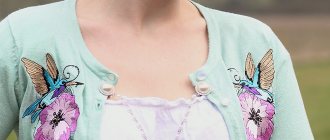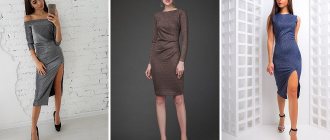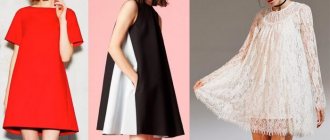Wedding fashion today is quite diverse and has many of the most extraordinary models. Some outfits are so extravagant that not every girl will dare to wear them. If the bride adheres to traditional solutions in creating an image, but wants something unusual, then the classic outfit can be complemented with original accessories. These models include a wedding dress with a red belt.
Photo for inspiration
Virtues and symbolism
A bright red belt on the bride’s formal white dress is a very catchy and beautiful accessory. This detail of the outfit makes the bride's image more mysterious and interesting. A girl in such decoration will look impressive and evoke admiring glances.
In addition, the belt is a functional detail. It accentuates the waist, making the figure slimmer. If the waist is high or low, a bright accent attracts attention, distracting from problem areas. A belt embroidered with rhinestones or embroidery is a decoration in itself for any outfit.
The symbolic meaning of white in wedding clothing is purity and innocence. White color emphasizes the grace and beauty of the young bride, creating a romantic, delicate image. Red symbolizes passionate feelings, ardent love. The combination of these two colors means bright romantic emotions of a tender girl towards her chosen one.
A wedding dress with bright red accents is suitable for bold and original girls. The belt can be complemented with other details of the same shade. These could be jewelry or wardrobe items. It is important that they are not too large.
Red is aggressive and exciting. Therefore, when decorating an outfit, you should limit yourself to two or three accessories of this shade. A small amount of this color brings cheerfulness and sensuality to the bride's image.
Photos of white wedding dresses with red belt 2021
Modern girls love originality, so for some of them, festive clothes with a red element would be an excellent option. There are many wedding models with a bright scarlet accent at the waist. From these, every future bride will be able to choose a festive decoration to her liking. Short, long with a train or fluffy dresses with a red belt will make the newlywed irresistible and beautiful.
Design features
This piece of clothing can be of different lengths, widths, shades and have decorations. It depends on the model and the preferences of the bride. The width may vary depending on the characteristics of the figure. It can also be a separate piece and tied or fastened over the outfit or be one-piece with a dress. The belt can be:
- In the form of a narrow ribbon, emphasizing a slender waist.
- Wide, performing a tightening function.
- With a decorative bow.
- Embroidered with rhinestones, sequins, etc., with embroidery or decorations.
This element can be made from the same fabric as the dress or from another material. They are mainly made from beautiful shiny fabrics, such as satin or satin. A satin belt on a lace white dress looks very beautiful. The fabrics of the outfit and additional elements should be combined in texture.
The belt can be not only red, but also in other shades: burgundy, hot pink, marsala, cherry, etc. Please note that if you add other accessories to the outfit, they must be the same tone.
Wedding bouquet for a red dress
In order to create a harmonious and complete image of a young bride and groom, the chosen toilet must be complemented with appropriate accessories. Including, the girl needs to choose a suitable bouquet. A bride in a red wedding dress will look best with a contrasting bouquet, for example, consisting of snow-white roses.
In addition, a mixture of red and white, red and yellow or red and pink flowers looks very good. If the young lady has given her preference to bright red roses, callas or peonies, such a bouquet must be decorated with green leaves or other types of decor so that it does not merge with the general background of the image.
Dress styles
Depending on the style, a belt or a ribbon imitating it can be located in different places of the outfit. This detail can be used in almost all wedding dress silhouettes.
High-waisted empire silhouettes typically use a narrow band that runs under the bust. A bright stripe will distract attention from other areas of the figure if there are problems there. This silhouette well masks imperfections in the hips and abdomen. The ribbon can be decorated with a small bow or cameo.
A voluminous, fluffy princess-style dress should be decorated with a wide belt so that it does not get lost in the folds. It can perform a slimming function, making a girl’s waist slimmer and more graceful. In this area, it is appropriate to complement such an element with a large bow that attracts attention.
In A-line dresses with a slight flare, made from light fabrics, a narrow or medium-width scarlet ribbon decorating the waist would be appropriate. It can have long ends that go down almost to the floor, and a small elegant bow. A belt that lightly touches the hips looks very feminine.
The mermaid style, which has a tight fit, can be decorated with a ribbon under the bust or on the hips, depending on where you want to make an accent. Please note that this particular part of the outfit will actively attract attention.
On a white wedding dress, a large scarlet bow that complements a wide belt looks very beautiful. This accessory stylishly decorates a lush multi-layered dress or a voluminous wavy hem. If the bow is at the back, it can be made very large and voluminous.
It can have very large and long ends that fall down the back of the skirt like a train. Large ribbons that follow the shape of the white train of the dress and are placed on top of it look very impressive. For this, satin, lace or chiffon material is used.
Traditional wedding dresses from around the world
In many countries, the wedding dress has retained the features of national traditions.
This manifests itself in color, style and details that correspond to customs and religious beliefs. Let's take a look at what kind of wedding dresses girls around the world wear: Bulgarian girl wearing a traditional wedding dress in the Rhodope Mountains.
Modern girls in Turkey get married in snow-white elegant dresses, but many years ago only red was considered a wedding color. The bride's dress itself was red, as was the scarf that was thrown over her head so that no one would see her beauty before her husband. Actually, the ancient red wedding dress has been modified into a red ribbon these days. Traditionally, the ribbon is tied around the bride's waist by the groom's brother or her close male relative. They say this means the bride’s purity and virginity, and this knot also connects 2 families. There is also the opinion that the red ribbon means “fertility”, that is, the bride should first of all give birth to many children, and there is also the opinion that the red color is a symbol of fire. This is from Zoroastrianism. And just as the fire takes everything for itself, so the groom takes the bride for himself.
Indonesia consists of about 8,000 inhabited islands and each of them has its own fashion for wedding dresses. Most often, girls dress in dresses of bright colors with heavy embroidery. Three days before the wedding, Indonesian women can paint their nails, hands and feet with henna. They draw birds and flowers.
At wedding ceremonies in Sri Lanka, brides mainly prefer sarees. There are many styles of finishing on a saree - embroidery, borders, hand dyeing. Sarees come in a variety of colors: white, red, blue, gold, etc. In addition to the traditional holiday color, there are unusual colors - indigo, azure, aqua. The border and edge are usually decorated with a large pattern that looks luxurious. According to ancient tradition, wedding sari is made from silk. For saris, thick silk is usually used. An opaque pattern is very complex, with many details, golden, silver threads or woven in various shades of the main background. The fabric shimmers in the light, fits well and does not wrinkle. It can have both a matte and glossy effect. Gold brocade thread is used on the border of some sarees. A mandatory attribute of a Sri Lankan bride is a bouquet of exotic flowers. The most important piece of wedding jewelry for a Sri Lankan bride is the nalalpata, a hair ornament. Nalalpata is worn only once in a lifetime, on the wedding day, and consists of chains of gold and precious stones extending from the middle to the sides of the head. The nalalpat headband has an attached plate in the frontal part depicting the moon and the sun, symbols of eternal love and lasting marriage. Such plates were traditionally worn by the royal rulers of Sri Lanka. Seven necklaces are usually worn around the neck, as the number 7 is considered a lucky number. Padakkam pendants are an important part of necklaces, each of which has its own name - peti malaya, agasthi malaya and seri valatu. The earrings, called dimithi, are shaped like an overturned cup with tiny dangling pearls.
Ultra-Orthodox Jewish brides, out of modesty, dress up in long dresses that hide everything except their face and hands. As a rule, lace flowing skirts reach to the floor.
The traditional attire of a bride in Tajikistan is an elegant dress over trousers. The ceremony can last several days, and during this time the bride changes her outfit several times.
Pakistani brides, no matter what social group they come from, are famous for their exquisite clothing and jewelry. Typically, for a wedding, they wear a long flowing dupatta and a head cover, decorated with painstakingly intricate patterns of beads, sequins, gold and silver threads. The long skirt is made from traditional silk or brocade. Jewelry includes a traditional nose ring, naskh, and a tiara glitters on the forehead along with other jewelry. Usually wedding clothes are red, but any other color is allowed. Brides may also wear sarees and salwars, depending on family traditions.
The bride and groom choose their wedding dresses independently. Traditionally, the bride's wedding sari should be red. Acceptable colors are gold, emerald, blue and pink. Black and white colors are prohibited. In different regions of India, different types of saris are worn, specific to a particular locality.
In Nubia, the bride wears three scarves: a colored one on her head, her face, and a heavy white one on top, which completely covers her head.
Traditional Eritrean wedding dresses include dark velvet crowns and purple dresses with gold embroidery. The bride's attire matches the groom's suit.
The Tuvan bride was decorated with silver jewelry (earrings, bracelets), and wore special wedding belt buckles (dergs), which were usually passed down by inheritance. In addition, new shoes with a curved toe were prepared for the bride, as well as for the groom, which is typical for the Tuvan costume. The bride, going to the groom's village, was placed on a white horse.
For the official ceremony, the Palestinian bride wears a fluffy white dress, but she must have a dress that was hand-embroidered by the bride's mother especially for the wedding. In the Peruvian capital of Lima, brides traditionally wear red and black dresses with layered cotton skirts and decorated hems.
Traditional Peruvian wedding attire is often colorful and includes woven capes and hats decorated with tassels and reflective material. A special skirt and poncho is made for the bride on her wedding day.
In Mali, the bride's attire is called a kaftan and is the same color as the dashiki, the groom's suit. The couple most often chooses white, but sometimes there are outfits in lavender or purple.
Korean brides wear the traditional hanbok costume. Wedding hanbok is colorful and symbolic. It consists of more parts than a regular hanbok. The bride wears a blue chima skirt, a yellow jeogori jacket and a long red wonsam coat with colored stripes on the sleeves. Sometimes, instead of the traditional blue chima, they wear a red one. The bride's hair is decorated with a hwagwan crown and special hairpins and ribbons.
The Japanese bride dresses up in a white kimono-shiromuku and a peculiar headdress - wataboshi - made of white cotton. He represents innocence and hides his face so that no one except the groom can see him. Such a round “bonnet” can only be combined with a white shiromuku kimono.
But a wedding kimono can be not only white, it can also be bright - it is (iroutikake), it is luxurious, heavy, with a train. His bride wears a white kimono on top, without tying it with an obi belt. It is combined with another headdress - tsunokakushi - a wide strip of white dense silk fabric, which is secured over the hairstyle with a high bun. Tsunokakushi translates to "hidden horns". There are different interpretations of why this headdress is called that way, according to some: “to hide the horns” means to hide anger, anger, becoming a gentle, kind and devoted wife. Taro jokes: “According to ancient Japanese beliefs, a grumpy and jealous wife grows horns and turns into an Oni demon. True true! And all men are “tenshi” - angels!” In any case, the bride herself chooses whether to “hide her horns” or not and in which kimono to appear at the celebration.
The Moroccan bride changes clothes throughout the celebration - changes dresses and jewelry up to seven times. As the main “star” of this event, she sits on the throne every time to admire and admire her appearance. The throne is carried around the hall for a better view. The last outfit is the traditional white dress.
The traditional color of a Chinese wedding is red. For centuries, Chinese brides have been wearing qipao, a bright red silk dress with intricate gold embroidery. These loose, high-necked, long-sleeved dresses fall to the ground, leaving only the head, arms and legs exposed. During the ceremony, the bride often changes dresses to show off her family's wealth.
Ghanaian newlyweds' costumes are usually very colorful. They match in color and style. Kente is used as the basis for clothing. Ghanaian craftswomen knit this fabric by hand. Distinctive features of the wedding image are multi-colored ornaments, brightness, bold lines.
A Mongolian wedding is full of traditions and rituals, the observance of which is a guarantee of a happy family life. In a traditional Mongolian wedding ceremony, both the bride and groom wear a patterned wedding suit (dil), the wearing of which is an age-old tradition of the Mongols and other nomadic peoples of Central Asia. One of the attributes of the outfit is a complex hairstyle and a small hat, to which numerous pendants are attached - silver, coral or turquoise beads.
Indonesia consists of about 8,000 inhabited islands. This country is home to more than 300 ethnic groups and has 6 major religions. Therefore, each island has its own fashion for wedding dresses. Most often, girls dress in dresses of bright colors with heavy embroidery. On some Indonesian islands, it is a tradition for the bride to paint her hands and feet with henna three days before the wedding.
Historically, there has not been a traditional wedding costume for a bride in Scotland. An important element of the wedding for the bride is the traditional “Luckenbooth” brooch, which, according to tradition, the husband should give the newlywed on the wedding day. The groom wears a Scottish kilt, festive hosiery (usually with red flushes), and traditional Scottish shoes. There are no pockets in a kilt. Their function is performed by the indispensable attribute of the sporran, which can be hung on the belt. The groom will definitely take with him a small stylized bag made of leather with fur.
Nigeria is a large country, home to about 250 ethnic groups speaking 500 dialects. Therefore, wedding ceremonies vary depending on the region. In the minds of Nigerians, a beautiful future wife is a girl with curves that are emphasized by a chic wedding dress. If previously brides had only traditional African wedding dresses, today they also have white dresses in European style. They are worn at the ceremony, and then the young wives change into colorful outfits. But all brides in Nigeria wear a voluminous headdress called Gele. They are a cross between a turban and a crown.
At a Kazakh wedding, the bride wears a traditional headdress - saukele - along with a veil. Saukeles are made long before the girl reaches marriageable age. Saukele is one of the most beautiful Kazakh headdresses worn by brides. People believed that he possessed enormous sacred power and protected the girl from evil glances and the evil eye.
Gorani are representatives of one of the nationalities of the Balkans. They are Muslim by faith, but their wedding traditions and customs often contain pagan elements.
An important attribute of a wedding ceremony in Turkmenistan is the bride’s dress. “Lucky” days were also chosen for cutting and sewing dresses; fabric for the wedding dress was obtained from the groom’s home. This dress was cut, starting with a blessing, by a woman respected in the village, a mother of many children. The remaining scraps were given to the bridesmaids as lucky talismans for a speedy marriage. The dress was made from red homespun silk fabric “ketene”. The color red was loved and revered by the Turkmens; people believed in its magical properties to protect people and help them in everything in life. The bride's dress was richly decorated with embroidery and a large number of silver and gilded jewelry, which, with their ringing sounds when walking, warded off evil spirits and served as amulets. In general, the bride was protected from evil forces in all available ways: they covered her from head to toe with capes, wove many amulets into her wedding dress, from camel hair braids to pig teeth, decorated the girl’s hands with various talismans against the evil eye (such an outfit could weigh up to 40 kg ). A special place in wedding ceremonies belongs to the bride’s special cape – “kurta”.
A real fairy tale begins during a wedding ceremony in Ukrainian mountain villages in the Carpathians. Even today, Hutsuls try to adhere to the wedding traditions that their grandfathers and great-grandfathers observed. They put on national clothes and beautifully decorate their houses, horses and trees. The couple rides decorated horses to the wedding.
As elsewhere, a wedding in northwestern Transylvania is an important event. As a rule, organizing a wedding falls on the shoulders of the parents, including conducting various rituals, preparing a dowry and costumes.
The Norwegian national costume and especially the wedding dresses of Norwegian brides are also beautiful, and the precious crowns are somewhat reminiscent of our kokoshniks. The traditional headdress for the bride was made in the form of a crown, and depending on the wealth of the family, it could be made of different materials, including silver and gold. The crowns of northern beauties were decorated with various pendants that made a gentle ringing sound when walking; this, according to legend, drove away the spirits of darkness from the bride. And the bride at the wedding had to dance until the crown fell off her head.
Traditional wedding dresses in Bali are very colorful and richly decorated. The bride and groom wear gold crowns on their heads during the official ceremony.
For her wedding, an Uzbek bride wears a very colorful and bright hand-embroidered outfit with beautiful patterns. It is sewn from the material khan-atlas
.
A national vest embroidered with folk patterns is worn over the dress. Then a silk robe or a velvet camisole embroidered with gold. Under the dress are national trousers, decorated with braid. It is customary to wear a national headdress on the head. For Uzbeks, this is an openwork kokoshnik with a large number of pendants, it is called tiplya-kosh
. The bride's face is covered with a veil. The wedding dress of an Uzbek bride can be complemented with a large amount of jewelry, including a nose ring, which is a symbol of fidelity. This is the custom and it says that a large number of decorations protects the bride from the evil eye.
Almost always an integral part of a Bedouin bride's outfit is a heavy veil, consisting of various pieces of jewelry.
The traditional Hungarian wedding dress of the bride is a dress embroidered with floral patterns and three bright colors. Under her dress, the girl wears many petticoats, and she often also wears an intricate headdress with ears of wheat woven into it.
Most weddings in Malaysia follow Muslim traditions. As a rule, brides wear dresses in purple, violet and cream colors.
In Germany, traditional wedding attire differs from region to region. For example, in the Black Forest valley, the wedding headdress is large and decorated with hundreds of beads and glass balls, while in Bakenburg the emphasis is more on flowers rather than beads.
As for Belarus, a wedding dress in the national style was a linen dress with red embroidery, if the bride was innocent, or a red sundress
over the shirt. The bride's head was necessarily covered with a velum - a veil that was attached to a wreath or headband. And at the waist there was a wide self-woven belt, decorated with traditional ornaments: images of cornflowers, the sun, birds, etc.
In Georgia in the past, a wedding dress for a bride was made of white satin or silk, but now the color palette is increasingly expanding in favor of other pastel colors - milky, blue, pink. The cut of the dress was the same as the cut of a casual dress, but what distinguished the festive outfit was the rich trimming. At the same time, the sleeves were double, the upper sleeve had a slit and was long, gracefully fluttering during the dance of the hero of the occasion and emphasizing her sophistication and tenderness. A belt decorated with gold, pearls and precious stones was worn around the bride's waist. The yoke of the dress, the upper sleeves, and the border of the lower sleeves were embroidered in a similar way. A velvet cap, also richly decorated with pearls and stones, was put on the bride’s head, and a veil was thrown over it to cover her face. As for shoes, Georgian girls preferred embroidered shoes with pointed upturned toes, which were comfortable to dance in.
Additional accessories
A fluffy white wedding dress with a red belt can be complemented with several accessories of the same shade. This could be: a handbag, a hat, jewelry (bracelet, hairpin), a bouquet, gloves, etc. In addition, the bride can wear red shoes if they are clearly visible from under the dress.
A red petticoat, slightly protruding from under the overskirt, harmonizes well with the vertical bright ribbon. A good accent can be the bride's lipstick, chosen to match the scarlet elements.
If the bride’s outfit includes a veil, it can be decorated with a ribbon to match the belt or made entirely of red material. The fabric of the veil should be light and transparent (chiffon or thin lace) so as not to overload the image.
The bow at the waist goes well with such a beautiful detail of a wedding dress as a corset. It adds romance to such a dress. The corset lacing can be made red, in which case the image will become more sensual and sexy.
Shades of red harmonize perfectly with all tones of white. More saturated tones, such as marsala, burgundy, cherry, complement cream, ivory, and champagne outfits well.
A lush white wedding dress combined with a scarlet belt looks very beautiful and unusual. This detail makes the bride's image more vivid and memorable. When complementing it with accessories in red shades, make sure not to disturb the harmony of the outfit.
Comments (0)
Accessories
A red belt should not be the only bright accessory in your look. It is worth maintaining its color in other details. So, if the dress is short, then the shoes can be red.
You can support the color of the belt with a large brooch of a similar shade , placing the decoration in the neckline or on the shoulder. The last option is good for a dress with an asymmetrical neckline and one strap.
An elegant solution is to use the color of the belt in decoration. For example, you can decorate the bodice of a dress or veil with red embroidery. If you choose a belt with a bow, then you should choose a short veil so that it does not cover the belt.
You can complement the look with elegant seals or mittens that match the color of the belt. It would be good if the gloves and belt had a similar decor.
When choosing a bouquet, make sure that it includes red flowers, but yellow or orange flowers should be avoided. Red flowers can be used not only in a bouquet, but also to decorate your hair.
Models for pregnant brides
The style in this case is selected taking into account the duration of pregnancy. If the girl’s tummy is very small, any style you like will do. Wedding dresses with a ribbon, as well as a fluffy hem and a bodice right under the bust, will help hide the waist area. It is extremely important that the bottom covers the rounded shapes, but under no circumstances squeezes.
For example, the bottom and top can be combined using a belt located under the chest. It is also possible not to use any connecting parts.
Regardless of which style is chosen, the tummy should not be tightly covered. The bride should feel as comfortable as possible throughout the day. That is why it is recommended to give preference to loose-fitting skirts.
A straight fitted dress would also be appropriate. In this case, the bodice and skirt are combined as smoothly as possible. The bottom does not have much volume. The shape of the skirt is similar to a pencil style, but a little more spacious.
In order to make the image even more delicate and sophisticated, attention should be paid to the following details:
- plume. It should be fixed in the shoulder area. Long, incredibly gentle waves that flow down to the floor create a fabulous look;
- shuttlecocks. Created by layering materials. As a rule, skirts are decorated in this way. Ruffles begin to form most often in the waist area. Due to this, the bow turns out to be much more spectacular and festive;
- lace. The lacy fabric can completely cover the satin base. Also, lace details are often used in the form of inserts. For example, guipure can alternate with satin on a skirt. It is best if the contrasting stripes are vertical;
- Basque. With the help of such decor, attention is drawn away from the protruding tummy and the waistline is effectively emphasized. This style, however, is suitable only in the first months of pregnancy.
Models with appliqués will also look original. For example, the outfit may have flowers or beautiful butterflies.
Shoes for a red wedding dress
The ideal choice for such a wedding dress is matching shoes, which, however, must completely match the color shade. Most styles of such dresses look great with high-heeled shoes, however, after a whole day they can cause discomfort, so after the end of the official ceremony it is better to change the shoes to comfortable ballet flats or sandals with low, stable heels or wedges.
In addition, a red wedding dress with gold can be complemented with golden shoes, which will make its owner a real princess, and an exquisite outfit made in red and white shades can be complemented with classic snow-white shoes without decor. Another universal option is beige shoes, which visually elongate the young bride’s legs and make them noticeably slimmer.

